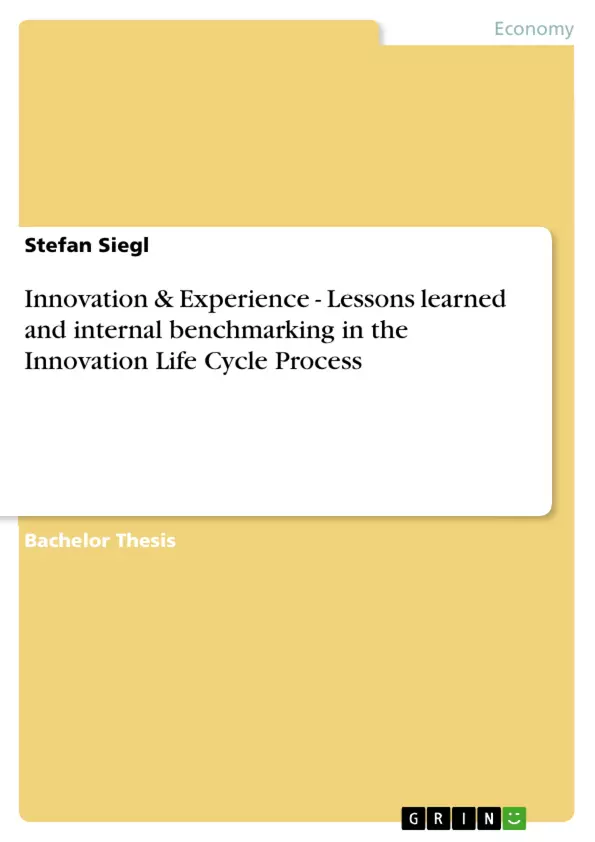Abstract
Innovation Management allows companies to stay competitive in fast changing markets. Nevertheless studies show that it is one of the least understood activities. The purpose of this thesis is to demonstrate capabilities for improving the innovation life cycle process. This thesis deals with the importance of Innovation Management itself and shows especially the innovation life cycle process. Therefore it focuses on internal benchmarking and lessons learned and how it could be applied in the innovation life cycle process. These findings indicate that internal benchmarking and lessons learned have a big capability for improving the innovation life cycle process, especially bringing experience into this process and help not doing things wrong twice. From these results we can conclude that it is recommended carrying out more detailed studies and analyses for different process steps. This thesis serves as a
prime basis for further investigations.
Zusammenfassung
Durch erfolgreiches Innovationsmanagement bleiben Firmen wettbewerbsfähig, dennoch zeigen Untersuchungen, dass Innovationsmanagement eines der am wenigsten verstandenen Tätigkeiten ist. Das Ziel dieser Arbeit ist es, mögliche Ressourcen für die Verbesserung des Innovationslebenszyklus-Prozesses aufzuzeigen. Die Arbeit befasst sich mit der Wichtigkeit von Innovationsmanagement und im speziellen des Innovationslebenszyklus-Prozesses. Deshalb wurde in dieser Bachelor-Arbeit die Möglichkeit des Einsatzes von internem Benchmarking und Lessons Learned in diesem Prozess beschrieben. Dabei wurde herausgefunden, dass ein beträchtliches
Potential für die Verkürzung des Prozesses vorhanden ist, da vorhandene Erfahrungen dazu genutzt werden können um Fehler nicht ein zweites Mal zu wiederholen. Es wird jedoch empfohlen für die jeweiligen Anwendungsgebiete genauere Studien und Analysen anzustellen. Diese Arbeit kann als Grundlage für weitere Forschungen herangezogen werden.
Inhaltsverzeichnis (Table of Contents)
- 1 Introduction
- 1.1 Motivation
- 1.2 Problem definition
- 1.3 Objectives
- 1.4 Target audience/group
- 1.5 Results expected
- 2 Innovation Management – the key driver for growth
- 2.1 Basics
- 2.2 Innovation Life Cycle Process
- 2.2.1 Idea Management
- 2.2.2 Process/Product Development
- 2.2.3 Launch/Continuous Improvement
- 3 Benchmarking
- 4 Lessons Learned
- 5 Applying internal Benchmarking and Lessons Learned in the Innovation Life Cycle Process
- 6 Visualisation of Problems
- 7 Conclusion
- 8 Bibliography and references
- 9 Appendix Contents
Zielsetzung und Themenschwerpunkte (Objectives and Key Themes)
This thesis aims to demonstrate the potential of internal benchmarking and lessons learned to improve the innovation life cycle process. It explores the importance of innovation management, particularly focusing on the innovation life cycle process, and examines how internal benchmarking and lessons learned can be effectively applied within this context.
- The significance of innovation management in maintaining competitiveness.
- Understanding the phases and challenges within the innovation life cycle process.
- The application of internal benchmarking as a tool for improving efficiency and avoiding past mistakes.
- The role of lessons learned in enhancing the innovation process.
- Exploring potential for improvement through the use of experience gained within the innovation life cycle process.
Zusammenfassung der Kapitel (Chapter Summaries)
- Chapter 1: Introduction: This chapter sets the stage for the thesis, providing motivation, a clear problem definition, outlining objectives, identifying the target audience, and highlighting anticipated results.
- Chapter 2: Innovation Management – the key driver for growth: This chapter delves into the fundamental aspects of innovation management, exploring the importance of innovation as a driving force for growth. It introduces the key concept of the innovation life cycle process and examines its different phases: Idea Management, Process/Product Development, and Launch/Continuous Improvement.
- Chapter 3: Benchmarking: This chapter focuses on the concept of benchmarking as a tool for improvement, explaining its purpose and outlining a five-phase concept of benchmarking.
- Chapter 4: Lessons Learned: This chapter discusses the significance of "lessons learned" as a crucial element in enhancing the innovation process, emphasizing the importance of learning from past experiences.
- Chapter 5: Applying internal Benchmarking and Lessons Learned in the Innovation Life Cycle Process: This chapter explores how internal benchmarking and lessons learned can be effectively implemented within the innovation life cycle process. It investigates methods for transferring experience and illustrates how experience can be brought into the process to avoid repeating mistakes.
- Chapter 6: Visualisation of Problems: This chapter focuses on visualizing the problems encountered during the innovation life cycle process, offering a visual representation of challenges and opportunities.
Schlüsselwörter (Keywords)
The key focus of this thesis lies in understanding the innovation life cycle process and exploring the potential of internal benchmarking and lessons learned as tools for improvement. This includes the importance of innovation management, the challenges faced within the innovation process, the effective implementation of benchmarking and lessons learned, and the role of experience in mitigating risks and enhancing efficiency. The application of these concepts in the innovation life cycle process contributes to a deeper understanding of how to improve the process and achieve successful innovation outcomes.
- Quote paper
- Stefan Siegl (Author), 2010, Innovation & Experience - Lessons learned and internal benchmarking in the Innovation Life Cycle Process, Munich, GRIN Verlag, https://www.grin.com/document/154758



